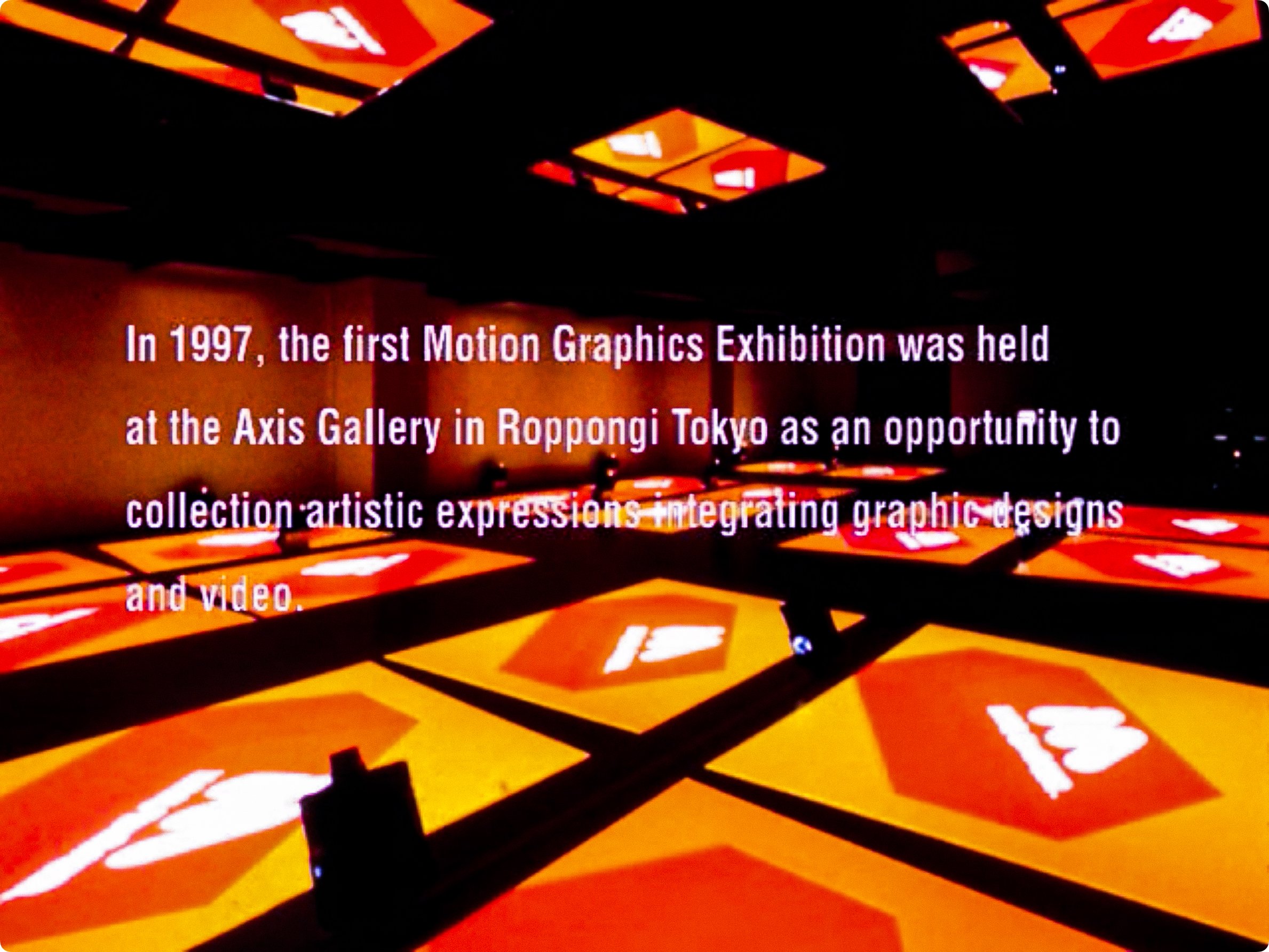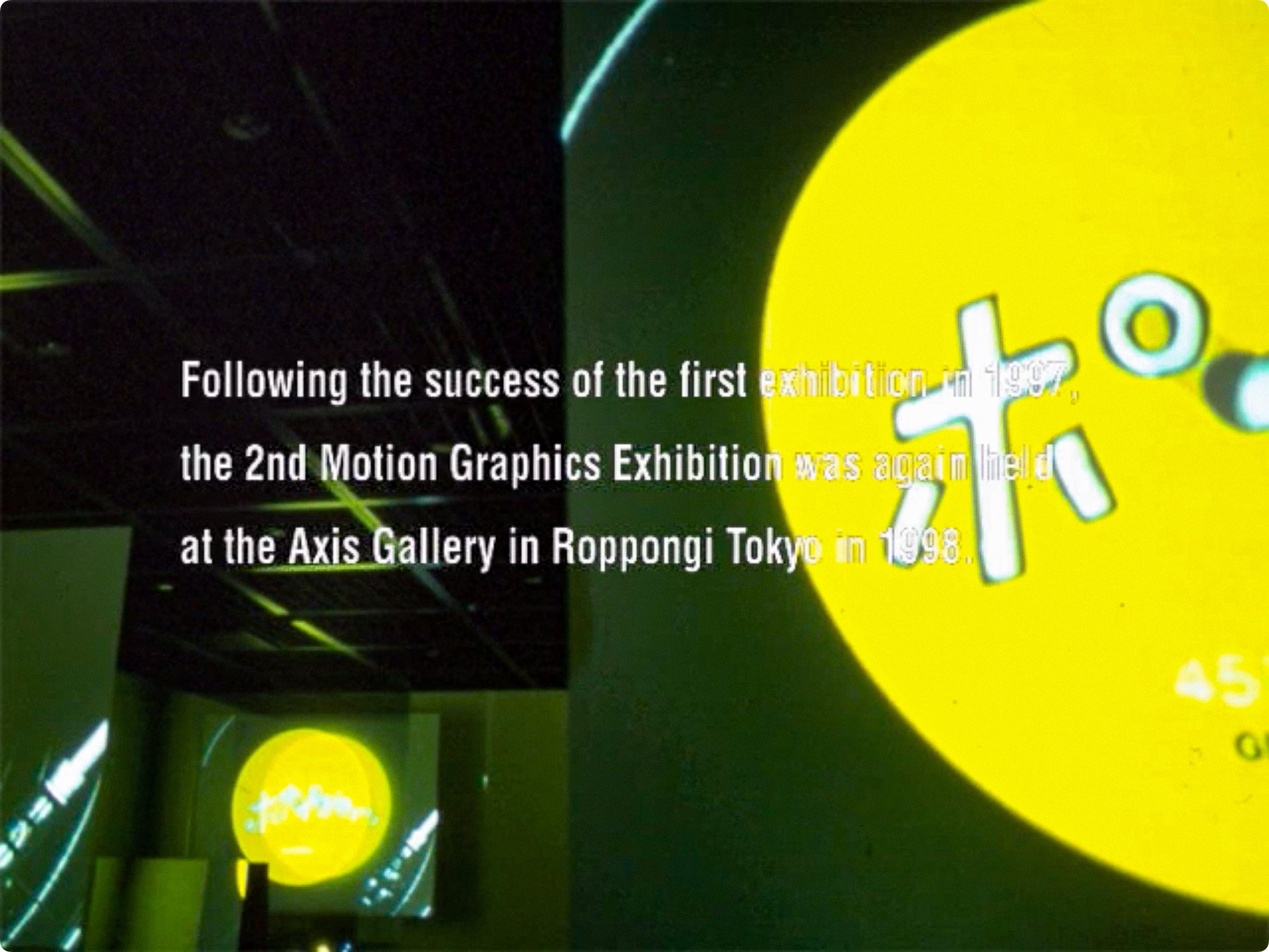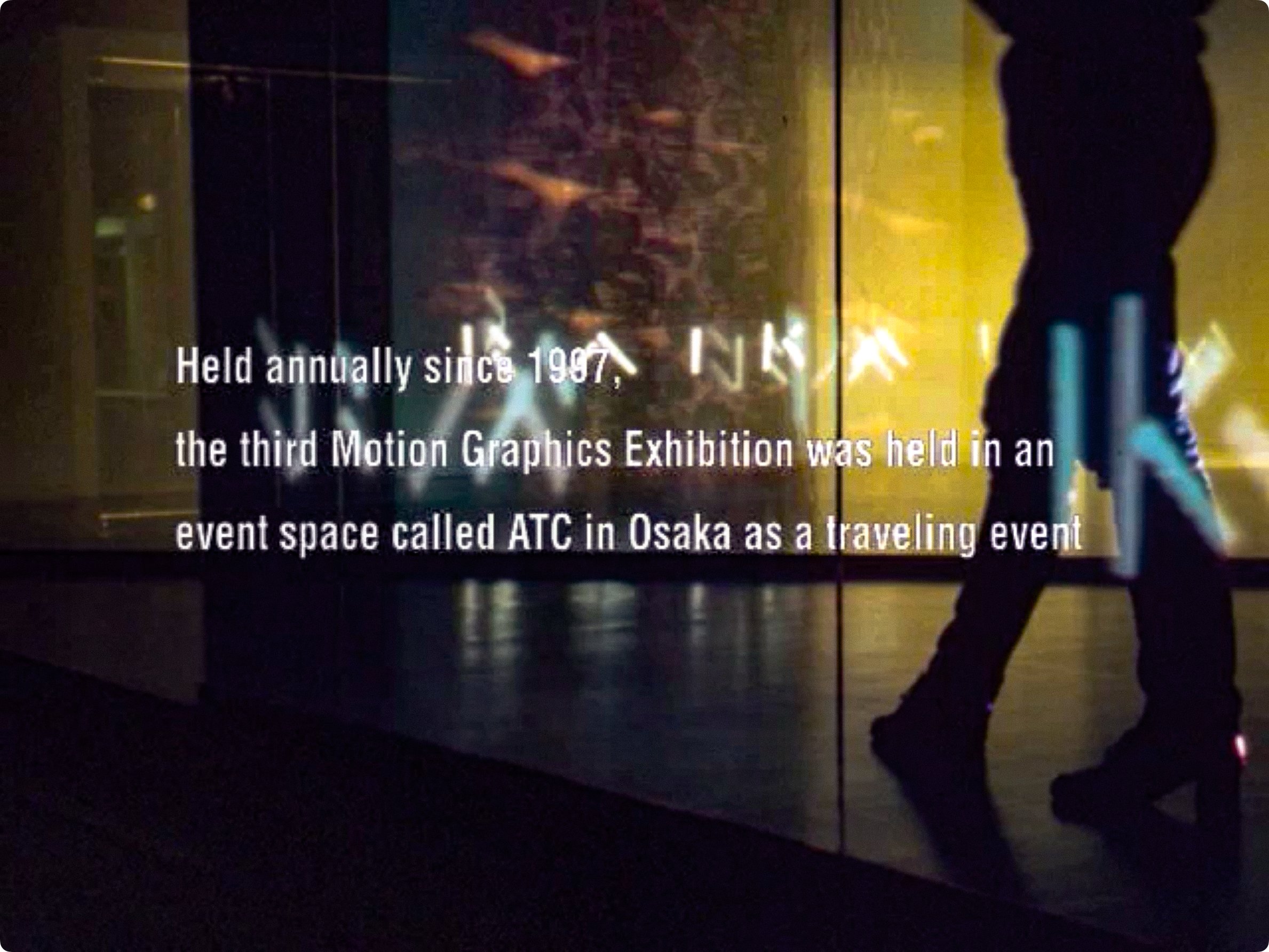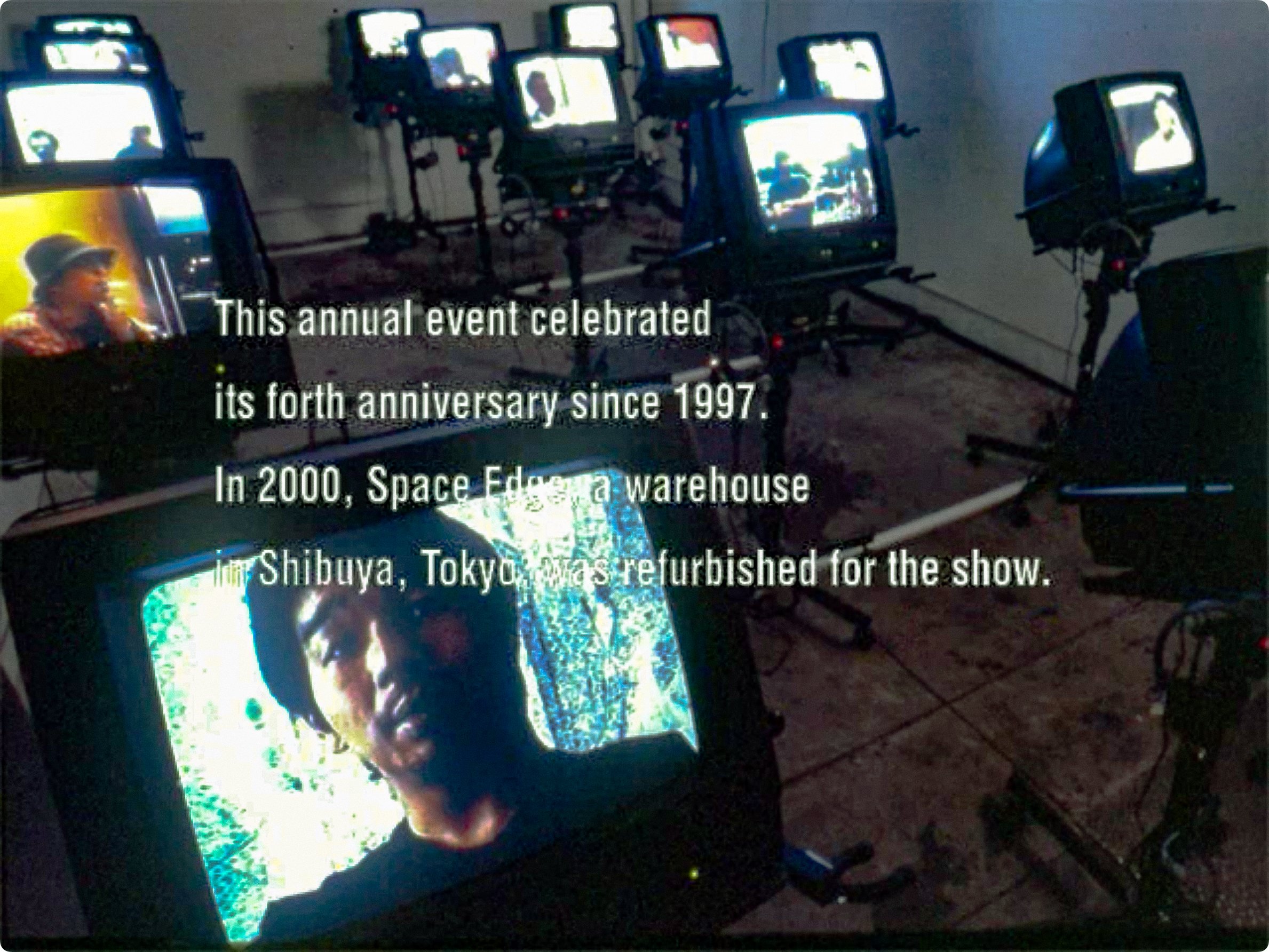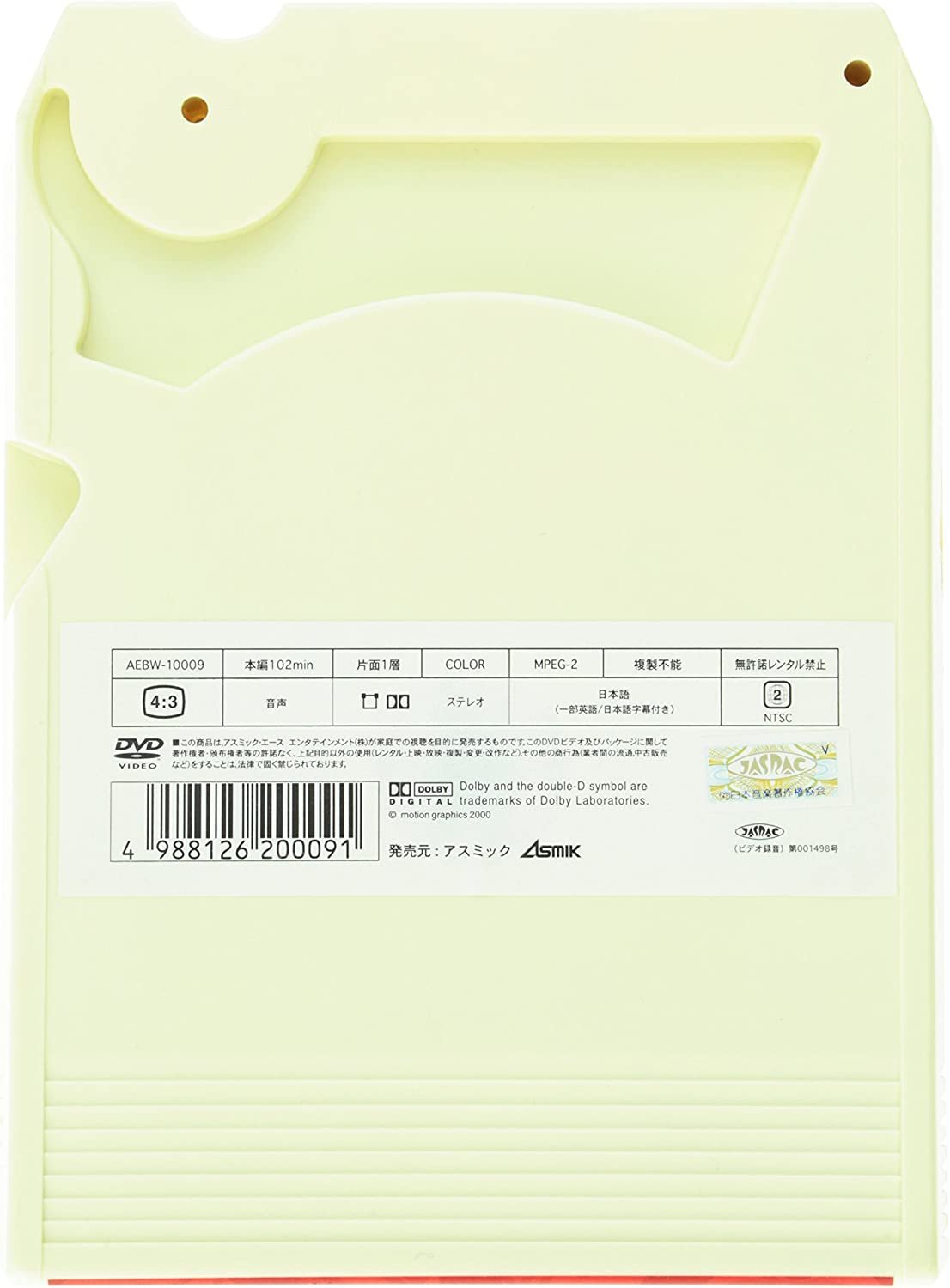
Motion Graphics Exhibition 1997-2000
〈Independent Exhibition〉
Exhibition - Produce / Planning / Direction / Management
The year 1997 was a year of dramatic change for Motion Graphics. Steve Jobs returned to Apple, Adobe After Effects 3.1 was released, and with the development of the Internet and devices, multimedia artists working on live space productions and fashion show installations were creating all kinds of expressions before the new century of the year 2000. The year 2000 was a new century, and multimedia artists were creating all kinds of expressions. It was around this time that the "Motion Graphics Exhibition" was held, bringing together creators and artists from a variety of genres, including graphic designer Kenmei Nagaoka and video artist Seiichi Hishikawa.
The beginning can be traced back to 1996, when Hishikawa, who had just returned from New York and was a freelance creator at the time, designed a display that projected images on the wall of the Aoyama store of "ISSEY MIYAKE". Kenmei Nagaoka, who happened to see the sign display, approached Hishikawa. In 1997, Nagaoka and Hishikawa came up with the definition of "the fusion of graphic design and video = Motion Graphics," which was the moment when the term "Motion Graphics" was coined for the first time in the world. This was also the moment when the term "Motion Graphics" was coined for the first time in the world.
Nagaoka and Hishikawa founded DRAWING AND MANUAL and began working to organize an exhibition of Motion Graphics, calling for sponsorship from Apple, Adobe, and numerous other media companies, and artists such as Kyle Cooper, Robert Bergman-Ungar, Gento Matsumoto, Ichiro Tanida, and Hideyuki Tanaka announced their participation. In the summer of 1997, the first "Motion Graphics Exhibition" was finally held. The theme was "Flying Logo" (at the time, this was the name given to a logo that moved). The exhibition consisted of two parts: a video exhibition of moving corporate logos that had already been actively used in commercials and other media, and a presentation of long-established brands such as "Toraya" and "MUJI" that did not have motion logos, with the creators moving their logos. The exhibition attracted approximately 6,000 visitors over the 10-day period. For an exhibition organized by a small, newly established design company, the response was far beyond expectations. "Motion Graphics Exhibition '98" was held the following year and was so well received that it was titled “Bakyun- Graphica(Beeow Graphica) " and was based on the idea of moving onomatopoeia from postwar Japanese manga. The exhibition presented onomatopoeia, which until then had expressed movement and emotion in a static manner, as Motion Graphics that included light and sound. Participating creators included groovisions, Jonathan Barnbrook, Razorfish, etc. For "Motion Graphics Exhibition '99," the venue was moved to Osaka, and the same theme as the 1997 exhibition was used to express the logos of companies mainly in the Kansai region using Motion Graphics. Participating creators included FUJIWAKI DESIGN, blacky, P.U.T, etc. In 2000, "Motion Graphics Exhibition 2000" was held at Space EDGE in Shibuya, Tokyo, with the theme of "Mogukara (Motion Graphics Karaoke)," in which Karaoke characters are moved. Participating creators included Art Durinski, Kiri Matsuura, NAMAIKI, and moss design unit, etc. The exhibition was suspended in 2000 when the Motion Graphics genre gained sufficient recognition. Looking back, it is clear that a distinguished lineup of graphic designers and video creators gathered for this exhibition. 20 years have passed, and with the advent of AI and other technologies, people have begun to explore the future of creativity in unprecedented ways. We are now planning to hold an exhibition in 2024 as the Japan Motion Crafts Exhibition, which will feature universal and new Japanese Motion Graphics expressions.
from Museum Magazine (1998)
Article
The widespread use of computers as a tool and technological advances have made possible a different approach to visual expression than the conventional one of moving graphics. Motion Graphics" is building a solid position as a new form of digital expression that moves from graphics to images using computers as a medium. Motion Graphics" is gaining ground as a new form of digital expression that moves away from computer graphics and toward video.
Following last year's highly successful "Motion Graphics '97," the second exhibition, "Motion Graphics '98," was held under the title "Postwar Japanese Manga's 'Onomatopoeia' Moves! The exhibition was titled "Postwar Japanese Manga's 'Onomatopoeia' Moves!
In contrast to the first exhibition, which dealt with the popular theme of "flying logos," the second exhibition was held under the title of "Onomatopoeia in Postwar Japanese Manga Moves! What happens when onomatopoeia moves? It raised a simple question, "What happens when onomatopoeia in manga moves?
The moment I rushed into the venue just before closing time, I was hit by a loud "gaga gaga gaga ----" sound in the darkness. mark on my head, I stood still and was hit by a flood of light, color, and sound. It was a motion graphics of the entire venue breathing.
The venue was composed of two rows of "walls" consisting of alternating rows of floor-to-ceiling glass partitions spaced at regular intervals with floating white panels suspended from the ceiling, glass mirrors standing on both sides of the glass, a projector, and speakers. Images are projected from the projector on the floor onto the mirrors, reflected onto the panels in mid-air, and then reflected back onto the glass, overlapping each other in multiple layers. The simple structure of the projector is devoid of any unnecessary objects, but when movement, light, and sound are added, the space is stirred, and "movement" is achieved.
Tokujin Yoshioka, who conceived the idea of "floating images" from "invisible sound," expressed it in the spatial design using only three materials: panels, glass, and mirrors. The way the images were presented, their balance, and even the details of how they fit together were so clear and exquisite as a solution to the concept that it convinced us that the drawing of the venue itself must be beautiful. The video director, Seiichi Hishikawa, supported the risk of the entire venue being under adjustment at the wrong moment from a technical standpoint, editing 16 "onomatopoeias" of about 10 seconds each equally using the format of the work to create an even larger flow of images and sounds. This allowed Kyle Cooper, Ichiro Yada, and the public to exist only as "onomatopoeia," creating the effect of immersing the viewer in a theatrical experience, drifting through time and space created by the undulation of strong images (the work) and weak images (the commentary).
When a flat surface (two-dimensional) that has been at rest acquires motion, it itself becomes pregnant with space (three-dimensional) and time (four-dimensional), and becomes a more experiential expression that engages the viewer's space and time. This is not only found in individual works, but the "Motion Graphics '98" exhibition itself was stimulating in its expression, and I believe that this is precisely the kind of exhibition made possible by the activities of creative professionals.
This project, which began with "Motion Graphics '97" and is expected to be held annually in the future, was inspired by Kenmei NAGAOKA, a creator himself. For these artists, who are responsible for keeping their eyes on the cutting edge of the times, always communicating new and high-level expressions widely with an eye on the market, and continuing to do so, seeking and coordinating venues for expression and critique is an activity that they desire because of their will and enthusiasm as creators. Planning, obtaining funding (sponsorship), selecting and negotiating with participating artists, subsequent correspondence, coordinating seminars, making announcements, creating official guides, setting up and running the venue, public relations activities, etc., etc., etc., etc., etc., etc. All of these tasks and financial activities are as much a challenge and a battle to develop the design genre to a higher level and to establish its position as well as a struggle to continue creating as an expressionist.
The fact that the first and second sessions were held during the period of SIGGRAPH, the world's most prestigious international conference in the design industry, shows the fearlessness and confidence of the organizers.
The third "Motion Graphics '99" is already taking shape. The landing point of the artists, which is still secret because they would be caught in the trap of revealing their concept, is also continuing to "move" as an unknown form of expression.
(Excerpt from the review article by Yumiko Oka of network museum & magazine project 1998)
AXIS magazine published in conjunction with the Motion Graphics exhibition, featuring "Motion Graphics
1998 Official guidebook published at the 2nd Motion Graphics Exhibition
Poster and flyer design for the 1999 Osaka exhibition
DVD released in conjunction with the 4th Motion Graphics Exhibition "Golden Mogokara(Motion Graphics & Karaoke)" in 2000
Special edition in an 8-track tape case that was used for karaoke in the Showa era
Opening image of the 1997 event
The opening image of the 1997 event, the first time it was held. The video was directed by Kazuma Morino, with original music by Yoshiyuki Usui and narration by John Kabila. Credits for participating artists include John Maeda and Robert Bergman-Anger.
Motion Graphics 1997 Opening Sequence
Director / Animator : Kazuma Morino
Music : USUI Yoshiyuki
Artist : Jon Kabira
Opening image of the 1998 event
Opening image of the second exhibition, held in 1998. The theme of the exhibition was "Manga Onomatopoeia in Motion. The video was directed by Kazuma Morino and the original music by Yoshiyuki Usui. The credits of participating artists, including Kyle Cooper and Art Durinsky, line up.
Motion Graphics 1998 Opening Sequence
Director / Animator : Kazuma Morino
Music : USUI Yoshiyuki
Opening video of the 2000 event
The theme for this year was "Move the Karaoke Characters. The opening video was presented as a work by Hishikawa. The original music piece "Still" by UBANI was used to express the letters in motion graphics. The video was shot on 16mm film and the letters were created using optical synthesis. This work was distributed by Dai-ichi Kosho to karaoke boxes nationwide for a limited period of two weeks to coincide with the exhibition.
Motion Graphics 2000 Opening Sequence
Director / Animator : Seiichi Hishikawa (DRAWING AND MANUAL)
Music : Morihito Kumano (DRAWING AND MANUAL)
Artist : UBANI
Motion Graphics Exhibition ‘97 Summary Movie
Motion Graphics 1997-2000 Overview Movie
Feature "Manga Onomatopoeia in Motion - Motion Graphics Exhibition" Cosmic Base - WOWOW 1998.7.11 O.A
Special feature "Motion Graphics" Fashion Communication - TV Tokyo 1998.7.20 On Air
Exhibition Participating Artists & Staff Credit
-
-Exhibition Configuration Overview-
AXIS Gallery , Roppongi Tokyo , 1997 Jul
Chief Producer : Kenmei Nagaoka
Space Design Director : Tokujin Yoshioka
Technical Director : Seiichi Hishikawa
Opening Sequence Creator : Kazuma Morino
Theme Music : Usui Yoshiyuki
Participation Artists
AXIS Design / Takashi Ishizu / Yasuhiko Uchihara / Kyle Cooper / GROOVISIONS / Junji Kojima / Tanaka Katsuki / Hideyuki Tanaka / Ichiro Tanida / Hironori Terai / Norio Nakamura / Pascal Roulin & PH Studio / Ichiro Higashiizumi / Seiichi Hishikawa / John Maeda / Yasuaki Matsuki / Takuya Matsunoki / Gento Matsumoto / Kazuma Morino / Noriyuki Morihara / Robert・Bergman=Unger
Production : DRAWING AND MANUAL
Coordination : AXIS Publishing
Management : Motion Graphics Exhibition Committee
-
-Exhibition Configuration Overview-
AXIS Gallery , Roppongi Tokyo , 1998 Aug
Chief Producer : Kenmei Nagaoka
Space Design Director : Tokujin Yoshioka
Technical Director : Seiichi Hishikawa
Opening Sequence Creator : Kazuma Morino
Theme Music : Usui Yoshiyuki
Participation Artists
Framegraphics / GROOVISIONS / DRAWING AND MANUAL / J.J.D / Stripe Factory / Razorfish / teevee graphics / AGES5&UP / BARNBROOK / DISTORTION
Production : DRAWING AND MANUAL
Coordination : AXIS Publishing
Management : Motion Graphics Exhibition Committee
-
-Exhibition Configuration Overview-
ATC , Osaka , 1999 Aug
Chief Producer : Kenmei Nagaoka
Space Design Director : Tokujin Yoshioka
Technical Director : Seiichi Hishikawa
Opening Sequence Creator : Seiichi Hishikawa
Participation Artists
AGES5&UP / Yasuyuki Okumur / Masato Okada / KOO-KI MOTION GRAPHICS /Kazuya Sasahara / Hidemune Shin / Kaname Shimonishi / Tatsuhiko Sugimoto / Soulmates Graphica / Masami Tanzi / FUJIWAKI DESIGN / Hiromi Hayashi / P.U.T / BLACKEY / Kiri Matsuura / cafe de yowaki
Production : DRAWING AND MANUAL
Management : Motion Graphics Exhibition Committee
-
-Exhibition Configuration Overview-
Space Edge, Shibuya, Tokyo , 2000 Aug
Chief Producer : Kenmei Nagaoka
Space Design Director : Mitsuhiko Nishi
Technical Director : Seiichi Hishikawa
Opening Sequence Director : Seiichi Hishikawa
Music : Morihito Kumano
Theme Song Artist : UBANI
Participation Artists
Ages 5&Up / Art Durinski / 第一興商クリエイティブチーム / Gento Matsumoto and Hiroshi Majima / Groovisions / Junji Kojima / Kiri Matsuura / KOO-KI MOTION GRAPHICS / Manabu Inada / NAMAIKI / moss design unit / 100LDK
Production : DRAWING AND MANUAL
Management : Motion Graphics Exhibition Committee
©Motion Graphics Exhibition Committee All Rights Reserved.
These are special public display for the Motion Graphics Exhibition materials. Copying or reproduction is strictly prohibited.

